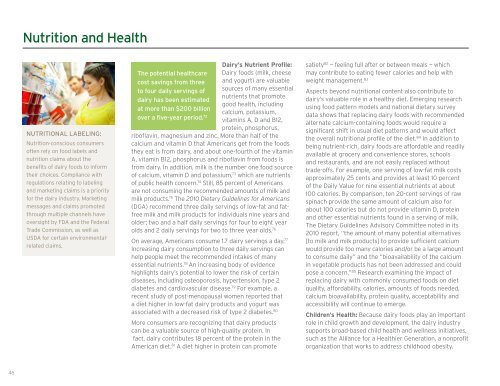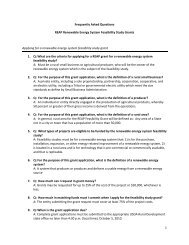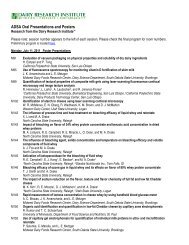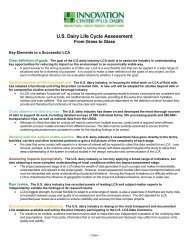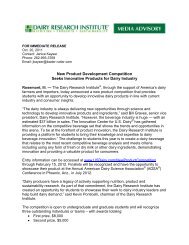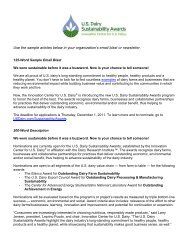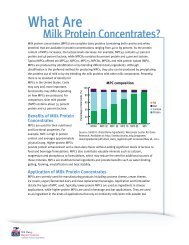2011 U.S. Dairy Sustainability Report - Innovation Center for US Dairy
2011 U.S. Dairy Sustainability Report - Innovation Center for US Dairy
2011 U.S. Dairy Sustainability Report - Innovation Center for US Dairy
Create successful ePaper yourself
Turn your PDF publications into a flip-book with our unique Google optimized e-Paper software.
Nutrition and Health<br />
NUTRITIONAL LABELING:<br />
Nutrition-conscious consumers<br />
often rely on food labels and<br />
nutrition claims about the<br />
benefits of dairy foods to in<strong>for</strong>m<br />
their choices. Compliance with<br />
regulations relating to labeling<br />
and marketing claims is a priority<br />
<strong>for</strong> the dairy industry. Marketing<br />
messages and claims promoted<br />
through multiple channels have<br />
oversight by FDA and the Federal<br />
Trade Commission, as well as<br />
<strong>US</strong>DA <strong>for</strong> certain environmentalrelated<br />
claims.<br />
The potential healthcare<br />
cost savings from three<br />
to four daily servings of<br />
dairy has been estimated<br />
at more than $200 billion<br />
over a five-year period. 72<br />
<strong>Dairy</strong>’s Nutrient Profile:<br />
<strong>Dairy</strong> foods (milk, cheese<br />
and yogurt) are valuable<br />
sources of many essential<br />
nutrients that promote<br />
good health, including<br />
calcium, potassium,<br />
vitamins A, D and B12,<br />
protein, phosphorus,<br />
riboflavin, magnesium and zinc. More than half of the<br />
calcium and vitamin D that Americans get from the foods<br />
they eat is from dairy, and about one-fourth of the vitamin<br />
A, vitamin B12, phosphorus and riboflavin from foods is<br />
from dairy. In addition, milk is the number one food source<br />
of calcium, vitamin D and potassium, 73 which are nutrients<br />
of public health concern. 74 Still, 85 percent of Americans<br />
are not consuming the recommended amounts of milk and<br />
milk products. 75 The 2010 Dietary Guidelines <strong>for</strong> Americans<br />
(DGA) recommend three daily servings of low-fat and fatfree<br />
milk and milk products <strong>for</strong> individuals nine years and<br />
older; two and a half daily servings <strong>for</strong> four to eight year<br />
olds and 2 daily servings <strong>for</strong> two to three year olds. 76<br />
On average, Americans consume 1.7 dairy servings a day. 77<br />
Increasing dairy consumption to three daily servings can<br />
help people meet the recommended intakes of many<br />
essential nutrients. 78 An increasing body of evidence<br />
highlights dairy’s potential to lower the risk of certain<br />
diseases, including osteoporosis, hypertension, type 2<br />
diabetes and cardiovascular disease. 79 For example, a<br />
recent study of post-menopausal women reported that<br />
a diet higher in low-fat dairy products and yogurt was<br />
associated with a decreased risk of type 2 diabetes. 80<br />
More consumers are recognizing that dairy products<br />
can be a valuable source of high-quality protein. In<br />
fact, dairy contributes 18 percent of the protein in the<br />
American diet. 81 A diet higher in protein can promote<br />
satiety 82 — feeling full after or between meals — which<br />
may contribute to eating fewer calories and help with<br />
weight management. 83<br />
Aspects beyond nutritional content also contribute to<br />
dairy’s valuable role in a healthy diet. Emerging research<br />
using food pattern models and national dietary survey<br />
data shows that replacing dairy foods with recommended<br />
alternate calcium-containing foods would require a<br />
significant shift in usual diet patterns and would affect<br />
the overall nutritional profile of the diet. 84 In addition to<br />
being nutrient-rich, dairy foods are af<strong>for</strong>dable and readily<br />
available at grocery and convenience stores, schools<br />
and restaurants, and are not easily replaced without<br />
trade-offs. For example, one serving of low-fat milk costs<br />
approximately 25 cents and provides at least 10 percent<br />
of the Daily Value <strong>for</strong> nine essential nutrients at about<br />
100 calories. By comparison, ten 20-cent servings of raw<br />
spinach provide the same amount of calcium also <strong>for</strong><br />
about 100 calories but do not provide vitamin D, protein<br />
and other essential nutrients found in a serving of milk.<br />
The Dietary Guidelines Advisory Committee noted in its<br />
2010 report, “the amount of many potential alternatives<br />
[to milk and milk products] to provide sufficient calcium<br />
would provide too many calories and/or be a large amount<br />
to consume daily” and the “bioavailability of the calcium<br />
in vegetable products has not been addressed and could<br />
pose a concern.” 85 Research examining the impact of<br />
replacing dairy with commonly consumed foods on diet<br />
quality, af<strong>for</strong>dability, calories, amounts of foods needed,<br />
calcium bioavailability, protein quality, acceptability and<br />
accessibility will continue to emerge.<br />
Children’s Health: Because dairy foods play an important<br />
role in child growth and development, the dairy industry<br />
supports broad-based child health and wellness initiatives,<br />
such as the Alliance <strong>for</strong> a Healthier Generation, a nonprofit<br />
organization that works to address childhood obesity.<br />
46


